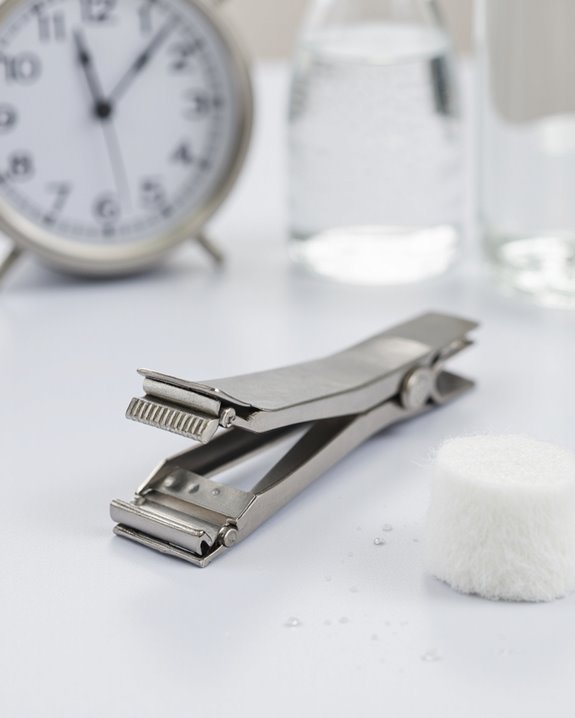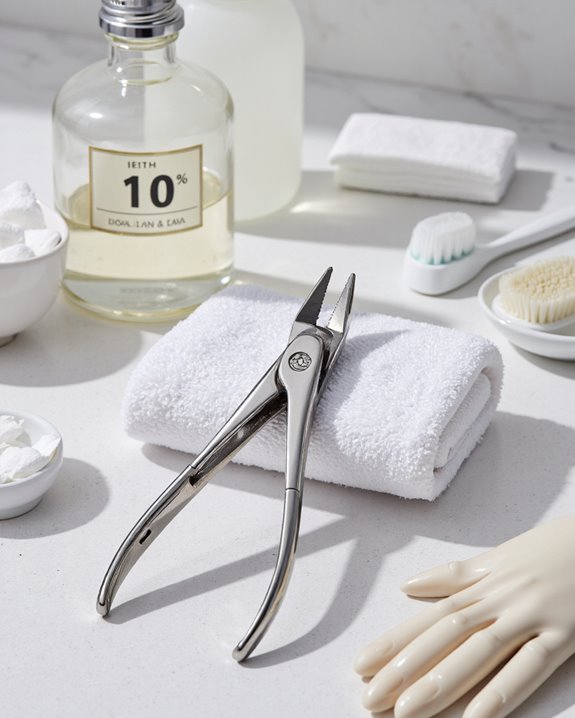HIV can survive on nail clippers for several hours up to a few days, though it rapidly loses 90-99% infectivity when exposed to air. The transmission risk is extremely low as the virus cannot spread through casual contact. To clean nail clippers properly, rinse under warm water, wipe with 70% alcohol, and soak in an EPA-registered disinfectant for 10 minutes. These simple steps provide effective protection against potential pathogens on personal care tools.
Key Takeaways
- HIV remains viable for several hours to a few days on nail clippers, but loses 90-99% infectivity within hours.
- Environmental factors like air exposure, sunlight, and drying fluids significantly reduce HIV survival on metal surfaces.
- CDC reports no documented cases of HIV transmission from dried blood on nail clippers or similar household items.
- Clean nail clippers by rinsing, wiping with 70% alcohol, then soaking in EPA-registered disinfectant for 10 minutes.
- Proper sterilization completely eliminates HIV risk, which is already minimal due to the virus’s poor survival outside the body.
HIV Survival Time on Surfaces Like Nail Clippers
The survival of HIV on nail clippers and similar surfaces presents less risk than many people fear, despite common misconceptions about transmission. Research shows that while HIV can live on nail clippers for several hours to a few days, it rapidly loses 90-99% of its infectivity within hours under normal environmental conditions. When bodily fluids containing HIV dry on metal surfaces, the virus becomes largely inactive, making the risk of HIV transmission extremely low. Additionally, the disinfection process effectively neutralizes any residual virus, further reducing potential transmission risk. The Centers for Disease Control confirms there are no documented cases of anyone contracting HIV from dried blood on household items like clippers. This is because HIV doesn’t survive well outside the human body, and the drying process substantially damages the virus’s structure. Environmental exposure to air, room temperature, and humidity all contribute to HIV’s quick degradation on surfaces.
Factors That Impact HIV Viability Outside the Body
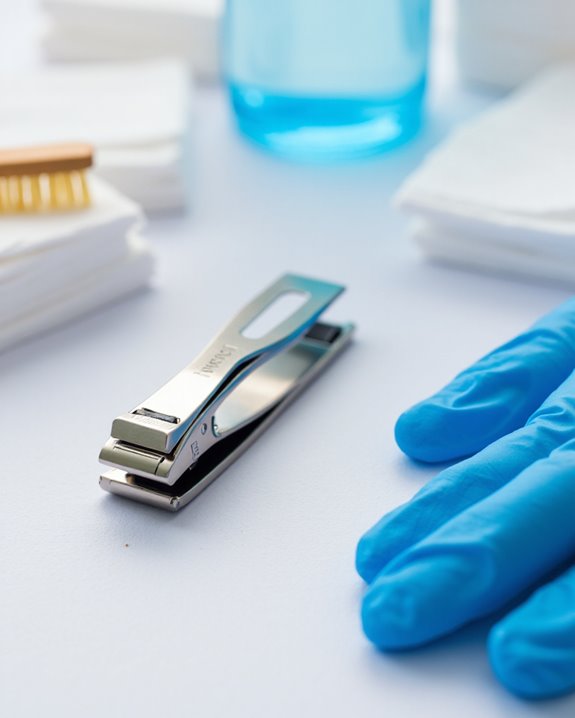
Several critical environmental factors determine how long HIV remains viable outside the human body, impacting its potential transmissibility from surfaces like nail clippers. Temperature plays a decisive role—HIV can’t survive prolonged exposure to heat, but the virus in blood can persist for up to 42 days at refrigeration temperatures compared to only 7 days at room temperature. Even in syringes: Effects of temperature dramatically alter survival rates. The virus degrades rapidly when exposed to sunlight or UV light, with humidity levels accelerating this process as fluids dry. Long does HIV survive for long? Only when conditions are just right—typically requiring moist environments and protection from light. Research examining HIV-1 in syringes: Effects show that even with higher viral loads, 90-99% of infectivity is lost within hours as bodily fluids evaporate. Additionally, the presence of certain disinfectants can significantly reduce the virus’s lifespan on surfaces like nail clippers.
Actual Risk of Transmission From Nail Salon Equipment
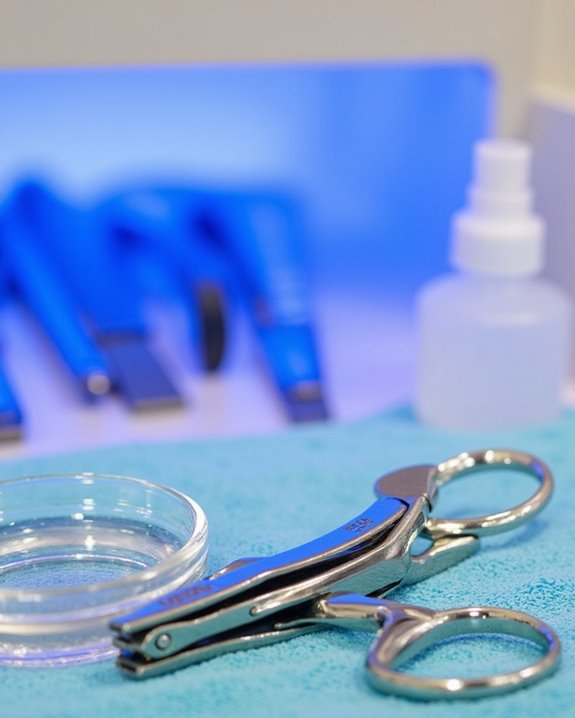
Given these environmental factors affecting HIV survival, we need to examine what they mean for real-world transmission risks in nail salons. The risk of getting HIV from manicure tools is highly unlikely according to the Centers for Disease Control and Prevention, as the human immunodeficiency virus is not transmitted through casual contact. For transmission to occur, fresh blood from an HIV-positive person would need to immediately contact an open wound on another individual—a scenario that rarely happens in practice. HIV is rendered 90-99% inactive within hours when exposed to air, making transmission from dried fluids on nail clippers virtually impossible. Proper sterilization protocols, which include effective disinfection procedures, further eliminate any potential risk by completely inactivating the virus. Simply put, HIV is not transmitted via salon equipment under normal circumstances, and proper sterilization protocols eliminate even theoretical risks by completely inactivating the virus.
Proper Cleaning and Disinfection Methods for Nail Clippers
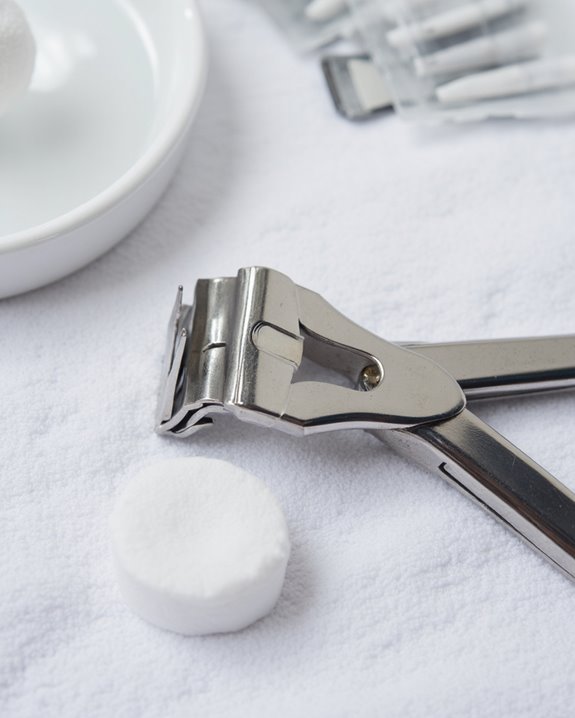
How effectively we clean our nail clippers can mean the difference between proper hygiene and potential infection risk, especially in salon settings where tools are used on multiple clients. While the HIV virus doesn’t survive long outside the human body, proper disinfection remains vital for Health Care professionals and individuals alike.
I recommend a three-step process: first, rinse under warm water to remove debris; second, wipe with a 70% alcohol disinfectant; finally, soak in an EPA-registered solution for 10 minutes. For professional settings, the Control and Prevention (CDC) guidelines are even stricter, requiring autoclaving at 121°C for complete sterilization—a standard far beyond what’s needed for preventing HIV transmission, which typically occurs through vaginal fluids or sharing needles, not nail care tools that have been properly cleaned.
Safety Precautions for Personal and Professional Nail Care
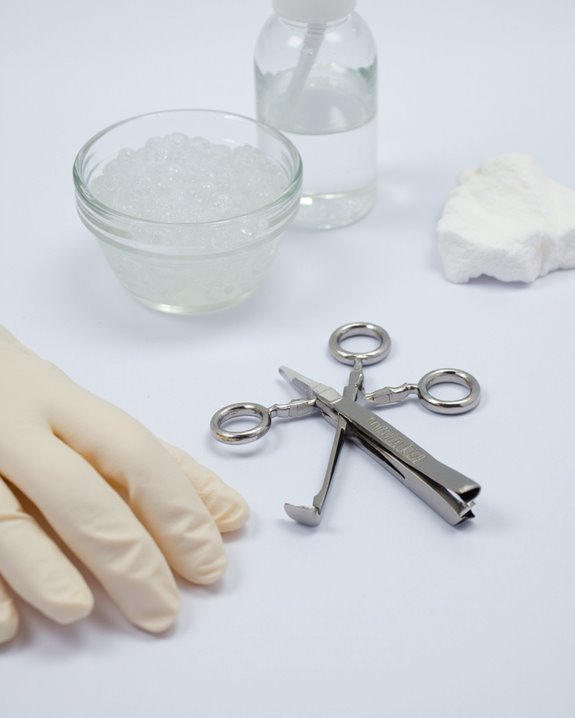
Taking proper precautions during nail care isn’t just about cleaning your tools—it’s about creating a thorough safety system that protects everyone involved. When one person uses nail tools on another person, I’d recommend treating these instruments with the same care you would toilet seat sanitation. For those with certain health conditions, I cannot provide medical advice, but I would say prevention is essential, much like Antiretroviral therapy is for HIV management.
The risk of transmission is much higher when tools aren’t properly sterilized. A person would need to use an EPA-registered disinfectant solution between uses, and professionals would need to follow CDC guidelines. I would say protecting your cuticles is vital—they’re natural barriers against infections that would otherwise create entry points for pathogens.
Frequently Asked Questions
How Long Can HIV Virus Survive on a Clipper?
I’ve found HIV persistence on clippers can range from hours to several days. Surface lifespan depends on environmental effects like humidity. Virus endurance decreases rapidly as contamination dries, with clipper viability ending within a week typically.
Can HIV Be Transmitted Through Finger Cut?
I’m addressing Transmission Myths about HIV. Blood Contact through Finger Wounds is theoretically possible but extremely rare. Viral Entry requires deep cuts, significant exposure, and direct contact with infected blood – Skin Barriers typically prevent Infection Pathways.
Can HIV Survive in Soap and Water?
No, I can’t stress enough that HIV’s water viability is extremely poor. Soap survival is non-existent as detergent effects dramatically accelerate virus inactivation. The surfactant role in cleaning efficacy guarantees complete hygiene impact against HIV.
How Many Seconds Does the HIV Virus Survive in the Air?
I’ll correct a common myth: HIV doesn’t survive “seconds” in air. The virus begins losing 90-99% infectivity within hours, not seconds. Air exposure reduces HIV’s atmospheric viability, but its airborne lifespan extends well beyond mere moments.

